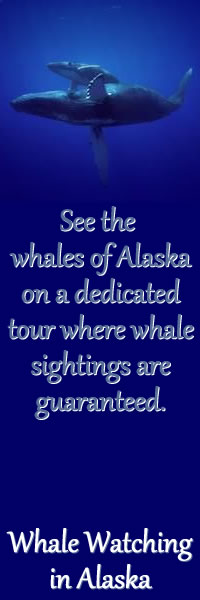 |
Alaska whale watching tours allow the visitors an opportunity to observe and photograph Humpback, Orca, Gray, and Beluga whales, along with many other marine mammals, in their natural environment. |
 |
|
Captains Choice Whale-Watching-Alaska.com |
 |
|
Contact Us At: |
 |
|
 |
|
Gray Whales of Alaska.For, Seward Alaska Gray Whale Watching tours from May through June, see Seward Gray Whale Tours. Gray Whales; Gray Whale Identification. The name for the gray whales comes from its mottled gray body color. They fiercely defended their calves and themselves against whalers, thus earning the nickname “devilfish”. This whale is now known for its curiosity. The gray whale is a baleen whale. The average length for the male gray whale is 39 feet with female being slightly larger. They live for over 40 years. They can be seen standing on their head in shallow water with their flukes above the surface. They may also raise their heads above water, slowing turning around to get a good look at its surroundings. Gray whales are usually alone or in small groups, however during feeding and mating season they form together in larger groups. When they breach they fall back at an angle creating a loud noise and a big splash. It is not known if they do this to clean off some of the sea lice or barnacles from their skin or as a means of communication. Gray whales are also popular for whale watching cruises because they are very curious about boats. They do not have a large range of sounds but make calls sounding like knocks, grunts and pulses. Their sounds are more prevalent with winter breeding months. They can communicate with one another over distances of a mile or more. The gray whale is able to stay under water for longer than 15 minutes and dives to depths of 550 feet. These whales prefer shallow, coastal waters and like to feed over oceanic continental shelves. When having their young, gray whales move into protected lagoons. Their average speed while swimming is 2-6 miles per hour but they can reach speeds of 10-11 miles per hour if they are in danger. When & Where To See Gray Whales in Alaska.Gray whales migrate from their winter feeding grounds in Baja California in late February and head up the Pacific coastline past Oregon, Washington, Canada up into Alaska. They have been known to travel 10,000 miles reaching the Bering Sea in May or June. Coastal towns like Ketchikan, Sitka, Seward and Kodiak are popular areas for seeing Gray whales in Alaska. April and May are the primary months for spotting them during their northern migration. Check out Seward Whale Watching for exact times. General FactsDuring the summer feeding months they feed in shallow coastal waters less than 200 feet deep. They are the only baleen whales to be bottom feeders. They roll over onto their sides sucking up sediment from the bottom of the sea floor. They eat tube worms, plankton, mollusks and small crustaceans found in the sediment. Predators of the gray whale are sharks, humans and killer whales. The whales are currently threatened by entanglement in fishing nets, collisions with ships, pollution and noise in the ocean. The population of the eastern north pacific gray whales is estimated at about 26,000 which has been enough of a recovery to take them off the endangered status in 1994. However the western north pacific gray whales are not doing as well with only about 100 animals left. All are now protected under the Marine Mammal Protection Act while in the oceans surrounding the United States. Gray WhaleCommon names: Gray Whales
Gray Whales in Alaska.The first gray whales typically show up in Alaskan waters in early April though most gray whale watching tours run from May through June. These whales are on their northern spring migration to the Bering Sea. The whales pass through on their southern migration in mid-October, passing through the coastal Alaskan waters between late October and early January. Whale Watching Alaska | Whale Watching | Whales in Alaska | Whale Watching Tours | Killer Whales Here on Whale Watching Alaska you will find information on Alaska whale populations, distributions and over all health. Promotes environmentally responsible whale watching trips featuring gray whale, killer whale, humpback whale, beluga and whale pod photo. Numbers obtained from the Alaska Dept. of Fish and Game and Noah. |
